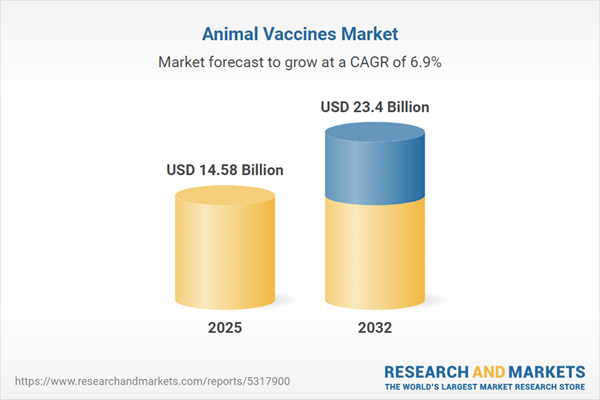Speak directly to the analyst to clarify any post sales queries you may have.
Senior leaders in the animal vaccines sector face a complex landscape defined by technological progress, regulatory shifts, and broadening global value chains. Strategic, data-driven intelligence is essential for guiding organizations through continual change and realizing new market opportunities.
Market Snapshot: Animal Vaccines Market Size and Growth
The animal vaccines market is forecast to expand from USD 13.69 billion in 2024 to USD 14.58 billion in 2025, representing a compound annual growth rate of 6.93%. Projections indicate the market could reach USD 23.40 billion by 2032. This trajectory is underpinned by increased investment in biotechnology and ongoing global scientific collaboration, which are critical for advancing production capabilities and widening commercial reach. Leading companies are prioritizing supply chain optimization, focusing on both companion animals and livestock. Partnership development and robust distribution initiatives are central components in sustaining ongoing market expansion.
Scope & Segmentation: Animal Vaccines Market
- Product Types: Inactivated, live attenuated, mRNA, recombinant, and subunit vaccines offer targeted, preventive solutions to meet diverse animal health needs.
- Animal Types: Solutions address both companion animals—such as dogs and cats—and production livestock, including poultry, cattle, pigs, and sheep. This ensures relevance for stakeholders from smallholders to large commercial operations.
- Disease Types: Portfolios address major bacterial, viral, fungal, and parasitic threats. Diseases such as rabies, avian and swine diseases, clostridial infections, and E. coli are targeted, reflecting the sector’s adaptability to regional health priorities.
- Route of Administration: Vaccines are available in injectable forms—such as intramuscular, intravenous, and subcutaneous—as well as oral applications, supporting flexible deployment in clinical and field environments.
- Distribution Channels: Products are supplied through online pharmacies, veterinary clinics, and retail outlets, increasing access for all animal health sectors globally.
- Geographic Coverage: The industry spans markets in the Americas, Europe, Middle East and Africa, and Asia-Pacific. Countries including the United States, China, India, Germany, Brazil, Japan, and Australia exhibit distinct market drivers and regulatory contexts.
- Key Company Profiles: Notable industry participants—such as Biogénesis Bagó S.A., Zoetis Inc., Merck KGaA, Boehringer Ingelheim International GmbH, Ceva Santé Animale, VIRBAC, Elanco Animal Health Inc., Indian Immunologicals Limited, and Vetoquinol SA—are recognized for their innovation and partnership models across global markets.
Key Takeaways: Strategic Insights for Senior Leaders
- Advanced platforms, including mRNA and recombinant vaccines, enable rapid response to new and evolving health threats within animal populations.
- Integrating digital tracking and monitoring technologies strengthens supply chain operations and enforces robust biosecurity protocols in the vaccine delivery process.
- Staying ahead of regulatory changes supports accelerated entry into diverse markets while mitigating operational disruptions.
- Diversifying vaccine lines across animal categories and disease profiles provides flexibility and tailored solutions for variable regional needs.
- Engaging multiple sales and distribution channels improves supply chain resilience and meets diverse demand patterns across regions.
- Investing in local manufacturing and regional partnerships enhances adaptability and accelerates organizational response to regulatory or logistical shifts.
Tariff Impact: Navigating Cost and Regulation in Animal Vaccines
New tariffs on raw materials in the United States beginning in 2025 are prompting shifts in how organizations approach sourcing and manufacturing. By expanding regional production capabilities and forming local alliances, companies are defending both product quality and affordability in light of evolving regulatory requirements. Building structured risk-management frameworks has become a necessity for leadership teams addressing ongoing regulatory and operational uncertainties.
Methodology & Data Sources
This report draws on expert interviews, comprehensive literature reviews, and verifiable industry data. Each insight is validated through cross-referencing, delivering an accurate and reliable platform for informed strategic decisions within the animal vaccines sector.
Why This Report Matters
- Guides strategic investments in innovative vaccine platforms and supply chain optimization, enhancing the efficiency and effectiveness of animal health operations.
- Identifies actionable opportunities across regions and segments, empowering senior leaders to allocate resources and bolster business resilience.
- Offers practical guidance to navigate regulatory complexity and technology adoption, safeguarding competitiveness and agility in evolving markets.
Conclusion
Continual innovation and well-informed strategy are foundational for success in the animal vaccines sector. Senior leaders leveraging strategic market intelligence are positioned to address emerging challenges and retain their organization’s leadership across value chains worldwide.
Additional Product Information:
- Purchase of this report includes 1 year online access with quarterly updates.
- This report can be updated on request. Please contact our Customer Experience team using the Ask a Question widget on our website.
Table of Contents
3. Executive Summary
4. Market Overview
7. Cumulative Impact of Artificial Intelligence 2025
Companies Mentioned
The companies profiled in this Animal Vaccines market report include:- Biogénesis Bagó S.A.
- BioVaxys Technology Corporation
- Boehringer Ingelheim International GmbH
- Brilliant Bio Pharma Private limited
- Ceva Santé Animale
- China Animal Husbandry Industry Co., Ltd.
- Dalan Animal Health
- Elanco Animal Health Inc.
- Endovac Animal Health, LLC by Immvac Inc.
- Hester Biosciences Limited
- HIPRA, S.A.
- Indian Immunologicals Limited
- Kemin Industries, Inc.
- Merck KGaA
- Neogen Corporation
- Phibro Animal Health Corporation
- SAN Vet Holding GmbH
- Sanofi S.A.
- Seppic S.A.
- Torigen Pharmaceuticals Inc.
- Vaxxinova GmbH
- VEROVACCiNES GmbH
- Vetigenics, LLC
- Vetoquinol SA
- Virbac, Inc.
- Zoetis Inc.
Table Information
| Report Attribute | Details |
|---|---|
| No. of Pages | 180 |
| Published | November 2025 |
| Forecast Period | 2025 - 2032 |
| Estimated Market Value ( USD | $ 14.58 Billion |
| Forecasted Market Value ( USD | $ 23.4 Billion |
| Compound Annual Growth Rate | 6.9% |
| Regions Covered | Global |
| No. of Companies Mentioned | 27 |









